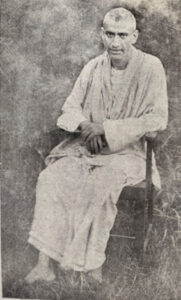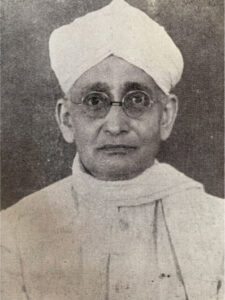Registered with the Registrar of Newspapers for India under R.N.I 53640/91
Vol. XXXI No. 5, June 16-31, 2021
Seventy-five years of a landmark
by Karthik Bhatt
The Ramakrishna Mission Vivekananda College, Mylapore is today one of the city’s most prominent educational institutions. Founded in 1946, it has played an important role in imparting what Swami Vivekananda termed as ‘man-making, character building education’. It has the distinction of producing several illustrious alumni who have reached great heights in diverse fields ranging from bureaucracy to fine arts. This article is a brief tribute to this hallowed institution which completes 75 years of existence this month.

Swami Kailasananda – first President.

D.S. Sarma, first Principal.

M. Subbaraya Iyer, Secretary.
The Vivekananda College was the product of the collective wisdom and resolve of several public-spirited personalities and legal luminaries such as Sir C.P. Ramaswamy Iyer, T.R. Venkatarama Sastri, Sir V.T. Krishnamachariar, Sir N. Gopalaswamy Iyengar and M. Subbaraya Iyer. They desired to establish a college where admission would be open to all based solely on merit without any distinction of caste or community. A number of meetings were held during August and September 1945 and it was decided to appeal to the public for donations. It was also decided to hand over the management of the proposed institution to the Ramakrishna Mission, which was already an established name in the field of education and social service. The Mission readily agreed to the proposal. In C. Ramanujachariar, the Secretary of the Ramakrishna Mission Students Home in Mylapore, the cause found a worthy ally. With the able support of Dr. Sir A. Lakshmanaswami Mudaliar, the Vice-Chancellor of the University of Madras, affiliation was secured and the college came into existence. Besides the aforementioned luminaries, the first Governing Body of the institution also included barrister V.L. Ethiraj, Justice N. Chandrasekara Iyer and the Chief Justice P.V. Rajamannar. The ex-officio members of the Governing Body comprised the President of the Ramakrishna Math at Madras, the Principal of the College and a nominee of the University of Madras. The first Principal of the College was D.S. Sarma, noted educationist and professor of English who had retired from Government service in 1938 and served as Principal of the Pachaiyappa’s College until 1941. Swami Kailasananda, the President of the Ramakrishna Math in Madras became the first President of the Management Committee.
On Akshaya Tritiya Day in May 1946, a portrait of Sri Ramakrishna was consecrated at the Ramakrishna Math and installed in the main hall of the college building, which came to be situated in what was known as the Nattukottai Nagarathar Vidyashala. This building had served as the High School section of the Ramakrishna Mission Students Home, which had shifted to Uthiramerur during the war.

The staff in the first year of the College.
On June 21, 1946 a puja marked the founding of the institution, after which C. Ramanujachariar rang the college bell to announce its opening. In a function held on July 1, Dr. Sir S. Radhakrishnan dedicated the college to the public, after which classes started. The response to the notice calling for applications had been tremendous, with more than 1,200 applying for a sanctioned strength of 350 students. 339 students were admitted and the college began its journey. The courses offered were Intermediate, B.A. Economics and Geography, B.Sc. Chemistry and Mathematics and B.Com. Over the next few years, affiliation was also obtained for additional courses such as B.A. Honours in Economics and B.Sc. Statistics. By 1957-58, the college had also started offering post graduate courses (MA programmes) in Economics, Philosophy and Mathematics. The student strength had also risen five-fold, to nearly 1,600.
The infrastructure of the college was steadily built over the years, with an open-air theatre constructed with a grant of the Central Government in the 1950s and hostel buildings constructed to house students in need of accommodation. Additional blocks were also constructed to meet the expanding requirements brought about by the introduction of new courses. A library with an impressive collection of books was also developed. The seeds were sown with the donation of around 4,000 books by the Students Home, which was augmented by the donation of around 2,000 books, four book shelves and two revolving book cases from the estate of Sir P.S. Sivaswamy Iyer. It is interesting to note that as early as its inception, the college library subscribed to 14 foreign and 16 Indian periodicals, thereby ensuring that the students had a wide body of knowledge at their disposal.

Pandit Jawaharlal Nehru addresses the College on July 26, 1948.
The Silver Jubilee of the college was celebrated in a grand 3-day function in September 1971, with the President of India V.V. Giri participating in the events. In 1974, the college added an Evening section to meet the growing demand for certain courses of study such as Computer Science and Commerce. In 2003-04, the college was accredited by NAAC, New Delhi for the first time and has been re-accredited ever since. The following year, the college was granted autonomous status by the UGC for all its undergraduate and post graduate programs, upto M.Phil.
The college has been served by several illustrious faculty members over the years such as Prof. C. Jagannathachariar (HOD, Tamil), Prof Dayanidhi Reddiar (Commerce), T.R. Raghava Sastri and N. Sundaram Iyer (both mathematics).
Right from its inception, the college placed immense emphasis on the importance of religious instruction on a broad non-sectarian basis. Weekly prayer sessions and lectures on religious topics by prominent people were an integral part of its routine. Extra-curricular activities were encouraged, with the NCC and Social Service League being very popular. By the end of the first decade of its existence, the College had ten student associations such as the College Union, the Indian Languages Association, the Science Association and the Fine Arts Society which conducted regular activities. Over time, these expanded to include the NSS, Youth Red Cross and the Rotaract Wings, all of which have undertaken a wide range of social activities.

Front view of Ramakrishna Mission Students Home in Mylapore. Picture courtesy Wikimedia Commons.
Participation in sports was also actively encouraged, with the college boasting of a rich cricketing tradition. The Vivekananda team was a dominant force at the inter-collegiate level for a long time. Several alumni of the college such as V. Sivaramakrishnan, U. Prabhakara Rao, T.E. Srinivasan and V.V. Kumar would go on to become Ranji Trophy and national cricketers. The baton has been carried on in recent years by the likes of M. Vijay and Abhinav Mukund. The college boasts of an excellent cricket ground which is in regular use for league cricket matches till date.
The college’s tryst with fine arts, especially Tamil theatre is well-known. A group of students across various disciplines in the mid-1950s, whose friendship blossomed over their love for theatre, founded a group named the Young Men Fine Arts, which was later rechristened as the Viveka Fine Arts. Several members of the troupe such as Neelu, Ambi, Jaishankar and Kathadi Ramamurthy would go on to become well-known names in the world of cinema and theatre over the next few decades. The troupe later became synonymous with Cho Ramaswamy. In the 1970s, the theatre tradition continued with the humourist Crazy Mohan writing skits for his brother Madhu Balaji’s team in the college. A little-known cultural connection of the college is that it played host to several performances during the formative years of the Mylapore Fine Arts Club that was established in 1951. The Club responded by organising fund raisers in aid of its benefactor.

The first issue of Viveka – the college magazine.
The college’s illustrious alumni include the likes of Y.V. Reddy (former RBI Governor), E.S.L. Narasimhan (former Governor of Andhra Pradesh and Chhattisgarh), noted columnist S. Gurumurthy, T.S. Tirumurthi (India’s serving Ambassador to the UN), Justice V. Ramasubramaniam, former CBI director R.K. Raghavan and renowned vocalist Sanjay Subrahmanyam.
It would be no exaggeration to say that the college in its journey has truly embodied Swami Vivekananda’s philosophy on education, which he defined ‘as the process by which character is formed, strength of mind is increased and intellect sharpened’.

The college’s present view.

